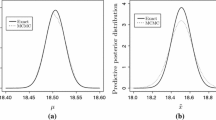Abstract
In Bayesian analysis, the so-called conjugate models allow obtaining the posterior distribution in exact form, in the sense that the posterior quantities can explicitly be written in a computable form. However, this class of models only involves a few structures, with some specific prior distribution for every data distribution. Although approximate methods such as numerical integration and MCMC are very efficient in Bayesian inference, little attention has been devoted to alternative views. In particular, the well-known conjugate Pareto-Gamma model is very restrictive, since the prior information can be expressed only through a Gamma distribution. In this work, we use special functions to extend the class of possible prior distributions that allow obtaining the posterior distribution in exact form. We give results that allow the use of any prior distribution within the broad class of H-functions. An example is provided to illustrate the theory.
Similar content being viewed by others
References
Amin, Z.H.: Bayesian inference for the Pareto lifetime model under progressive censoring with binomial removals. J. Appl. Stat. 35(11), 1203–1217 (2008)
Andrade, J.A.A., O’Hagan, A.: Bayesian robustness modelling using regularly varying distributions. Bayesian Analysis. 1(1), 169–188 (2006)
Andrade, J.A.A.: Exact posterior computation for the binomial-Kumaraswamy model. Adv. Comput. Math. 46(6), 1–14 (2020)
Andrade, J.A.A., Rathie, P.N.: On exact posterior distributions using H-functions. J. Comput. Appl. Math. 290, 459–475 (2015)
Andrade, J.A.A., Rathie, P.N.: Exact posterior computation in non-Conjugate Gaussian location-scale parameters models. Communications in Nonlinear Science and Numerical Simulation. 53, 111–129 (2017)
Andrade, J.A.A., Rathie, P.N., Farias, R.B.A.: Exact Bayesian computation using H-functions. Comput. Appl. Math. 38, 2277–2293 (2018)
Dixit, U.J., Nooghabi, J.M.: Bayesian inference for the Pareto lifetime model in the presence of outliers under progressive censoring with binomial removals. Hacettepe J. Math. Stat. 46(5), 887–906 (2017)
Fox, C.: The G and H functions as symmetrical Fourier kernels. Trans. Am. Math. Soc. 98, 395–429 (1961)
Gasper, G., Rahman, M.: Basic Hypergeometric Series. Encyclopedia of Mathematics and its Applications 96 (2nd ed.). University Press, Cambridge (2004)
Luke, Y.L.: The Special Functions and Their Approximations. Academic Press, New York (1979)
Mathai, A.M., Saxena, R.K., Haubold, H.J.: The H-Function: Theory and Applications. Springer, New York (2010)
Balakrishnan, Cramer, E.: The Art of Progressive Censoring, Springer, New York, USA (2014)
Pericchi, L.R., Smith, A.F.M.: Exact and approximate posterior moments for a normal location parameter. J. Roy. Statist. Soc. Ser. B. 54(3), 793–804 (1992)
Psarakis, S., Panaretos, J.: The folded t distribution. Communications in Statistics - Theory and Methods. 19(7), 2717–2734 (1990)
Rigaill, G., Lebarbier, E., Robin, S.: Exact posterior distributions and model selection criteria for multiple change-point detection problems. Stat. Comput. 22(4), 917–929 (2012)
Scollnik, D.P.M.: A Pareto scale-inflated outlier model and its Bayesian analysis. Scand. Actuar. J. 3, 201–220 (2015)
Srivastava, H.M., Gupta, K.C., Goyal, S.P.: The H -function of One and Two Variables with Applications. South Asian Publishers, New Delhi (1982)
Sun, F., Cao, Y., Zhang, S., Sun, H.: The Bayesian Inference of Pareto Models Based on Information Geometry. Entropy. 23(45), (2021). https://doi.org/10.3390/e23010045
Vilar-Zanón, J., Lozano-Colomer, C.: On Pareto Conjugate Priors and Their Application to Large Claims Reinsurance Premium Calculation. ASTIN Bull. 37(2), 405–428 (2007). https://doi.org/10.1017/S0515036100014938
Villa, C.: Bayesian estimation of the threshold of a generalized Pareto distribution for heavy-tailed observations. TEST 26(1), 95–118 (2017)
Author information
Authors and Affiliations
Corresponding author
Ethics declarations
The authors declare no competing interests.
Additional information
Communicated by: Akil Narayan
Publisher's Note
Springer Nature remains neutral with regard to jurisdictional claims in published maps and institutional affiliations.
Appendix: Proofs
Appendix: Proofs
Proof
The likelihood of a Pareto distribution is given by
where \(t=\min (x_i)\) and \(k_1=1/\prod _{i=1}^k x_i\). We write the unnormalized posterior moments in terms of H-functions,
The result follows by Theorem 3, by letting \(\alpha _{1}=k+1\), \(m=q=1\), \(n=p=0\), \(a=\sum _{i=1}^k\log \left( \frac{x_i}{x_m}\right) \), \(b=1\) and \((b_{1},B_{1})=(0,1)\). \(\square \)
Proof of Theorem 4
Considering the posterior distribution (11),
From Definition 1, letting U be the integral above, we have
Hence the result follows from Definition 1. \(\square \)
Proof of Theorem 5
The posterior predictive distribution is
If we combine \(L_{\widetilde{x}}(\theta )\) and \( L_{\textit{x}}(\theta )\), we have
where \(k_1'=(\widetilde{x}\prod _{=1}^k x_i)^{-1},\,\alpha _{1}'=k+2\), \(a'=\log \left( \widetilde{x}/x_{m}\right) +\sum _{i=1}^k\log \left( x_{i}/x_{m}\right) \) and \(b'=1\).
It follows that we have the same situation as in Theorem 4, that is a likelihood function \(L_{\widetilde{x},\textit{x}}'(\theta )\) and the prior distribution \(p(\theta )\), hence we can apply Theorem 3 with \(r=0\) and the result follows. \(\square \)
Rights and permissions
Springer Nature or its licensor (e.g. a society or other partner) holds exclusive rights to this article under a publishing agreement with the author(s) or other rightsholder(s); author self-archiving of the accepted manuscript version of this article is solely governed by the terms of such publishing agreement and applicable law.
About this article
Cite this article
Andrade, J.A.A., Rathie, P.N. Exact posterior distribution for nonconjugate Pareto models. Adv Comput Math 49, 35 (2023). https://doi.org/10.1007/s10444-023-10030-6
Received:
Accepted:
Published:
DOI: https://doi.org/10.1007/s10444-023-10030-6




